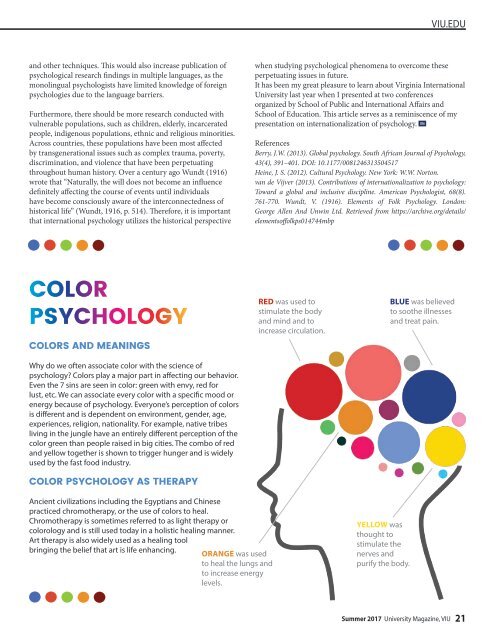VIU_Magazine_Summer_2017
VIU_Magazine Summer 2017
VIU_Magazine Summer 2017
You also want an ePaper? Increase the reach of your titles
YUMPU automatically turns print PDFs into web optimized ePapers that Google loves.
<strong>VIU</strong>.EDU<br />
and other techniques. This would also increase publication of<br />
psychological research findings in multiple languages, as the<br />
monolingual psychologists have limited knowledge of foreign<br />
psychologies due to the language barriers.<br />
Furthermore, there should be more research conducted with<br />
vulnerable populations, such as children, elderly, incarcerated<br />
people, indigenous populations, ethnic and religious minorities.<br />
Across countries, these populations have been most affected<br />
by transgenerational issues such as complex trauma, poverty,<br />
discrimination, and violence that have been perpetuating<br />
throughout human history. Over a century ago Wundt (1916)<br />
wrote that “Naturally, the will does not become an influence<br />
definitely affecting the course of events until individuals<br />
have become consciously aware of the interconnectedness of<br />
historical life” (Wundt, 1916, p. 514). Therefore, it is important<br />
that international psychology utilizes the historical perspective<br />
when studying psychological phenomena to overcome these<br />
perpetuating issues in future.<br />
It has been my great pleasure to learn about Virginia International<br />
University last year when I presented at two conferences<br />
organized by School of Public and International Affairs and<br />
School of Education. This article serves as a reminiscence of my<br />
presentation on internationalization of psychology.<br />
References<br />
Berry, J.W. (2013). Global psychology. South African Journal of Psychology,<br />
43(4), 391–401. DOI: 10.1177/0081246313504517<br />
Heine, J. S. (2012). Cultural Psychology. New York: W.W. Norton.<br />
van de Vijver (2013). Contributions of internationalization to psychology:<br />
Toward a global and inclusive discipline. American Psychologist, 68(8).<br />
761-770. Wundt, V. (1916). Elements of Folk Psychology. London:<br />
George Allen And Unwin Ltd. Retrieved from https://archive.org/details/<br />
elementsoffolkps014744mbp<br />
COLOR<br />
PSYCHOLOGY<br />
COLORS AND MEANINGS<br />
Why do we often associate color with the science of<br />
psychology? Colors play a major part in affecting our behavior.<br />
Even the 7 sins are seen in color: green with envy, red for<br />
lust, etc. We can associate every color with a specific mood or<br />
energy because of psychology. Everyone’s perception of colors<br />
is different and is dependent on environment, gender, age,<br />
experiences, religion, nationality. For example, native tribes<br />
living in the jungle have an entirely different perception of the<br />
color green than people raised in big cities. The combo of red<br />
and yellow together is shown to trigger hunger and is widely<br />
used by the fast food industry.<br />
COLOR PSYCHOLOGY AS THERAPY<br />
RED was used to<br />
stimulate the body<br />
and mind and to<br />
increase circulation.<br />
BLUE was believed<br />
to soothe illnesses<br />
and treat pain.<br />
Ancient civilizations including the Egyptians and Chinese<br />
practiced chromotherapy, or the use of colors to heal.<br />
Chromotherapy is sometimes referred to as light therapy or<br />
colorology and is still used today in a holistic healing manner.<br />
Art therapy is also widely used as a healing tool<br />
bringing the belief that art is life enhancing.<br />
ORANGE was used<br />
to heal the lungs and<br />
to increase energy<br />
levels.<br />
YELLOW was<br />
thought to<br />
stimulate the<br />
nerves and<br />
purify the body.<br />
<strong>Summer</strong> <strong>2017</strong> University <strong>Magazine</strong>, <strong>VIU</strong><br />
21

















